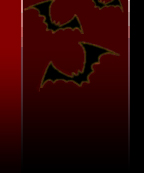|
Symphony of the Night: Foreign Release Info


In Japan, the game is known as Akumajou Dracula X: Gekka no Yasoukyoku (Nocturne in the Moonlight.) The initial release included a small art booklet and music CD with a compilation of tracks from previous Castlevania games.
Surprisingly little was changed in the conversion to English. The Japanese version had several famous voice actors, and when you beat the game, you could listen to interviews with them. As this would be pointless to most English players, it was replaced with a sound test (accessible from the Master Librarian.) A lot of the enemy and weapon names were changed - many were altered to references to Tolkein mythology.
In the Japanese version, the scrolling text intro is in English with a Japanese voiceover. They rewrote some of the text in the English version, for some reason. Most of it is better, at least, but judge for yourself.
Ending A: Fight Richter Before Getting Holy Goggles

|
English:
It was Richter Belmont, the legendary vampire hunter, who succeeded in finally ending the menace of Count Dracula, Lord of the Vampires who had been brought back from the grave by the dark priest Shaft.
However, one night 4 years later, under the glare of a full moon, Richter mysteriously vanished.
With no idea of where to begin her search, Maria Renard set out to look for him. It was then that fate intervened.
Castlevania, the castle of Dracula, which is rumored to appear once every century, suddenly materialized from out of the mist as if to show her the way.
Meanwhile, powerful forces were struggling for the soul of a man named Alucard.
The very same Alucard who had teamed up with Trevor Belmont to battle his immortal father, Count Vlad Tepes Dracula.
Alucard, in order to purge the world of his own cursed blood line, had submerged his vampiric powers and entered into was supposed to be an eternal slumber. But now, he is awake and aware of the evil once again at work in his homeland.
This time has once again come for the forces of Good and Evil to engage in their ancient battle. Dracula's castle beckons you.
And no man can say who shall emerge victorious.
|
Japanese:
After a series of epic battles, Richter Belmont finally succeeded in destroying Count Dracula, the ancient vampire who had been most recently resurrected by the dark priest Shaft.
However, one night 4 years later, under the bright glare of the moon, Richter mysteriously vanished.
With no idea of where to begin her search, Maria Renard set out to look for him. It when then that fate intervened.
Castlevania, the castle of Dracula, which is rumored to appear only once every century, suddenly and mysteriously materialized.
Meanwhile, powerful forces were at work in the life of a man named Alucard.
The very same Alucard who had previously teamed up with Ralph C. Belmont to destroy his immortal father, Vlad Tepes aka Count Dracula.
Alucard, in order to rid the world of his own cursed bloodline, sealed off his powers and entered into what was supposed to be an eternal slumber. But now, that sleep has been disturbed and Alucard is aware of the evil that is once again arisen in his homeland.
The time has come once more for the forces of Good and Evil to engage in their ancient battle. Dracula's castle beckons for you.
And perhaps none but that bright and glaring moon can say who will be triumphant.
|
The "Game Over" screen was misspelled originally. It was originally "Let us go out the evening for pleasure. The night is still young." This was corrected in the English version. Also, the Japanese version had special voice clips that replaced the usual Game Over music, depending on whether you died fighting Shaft, the Succubus or others. These were removed from the English version (although they were still recorded.)
The European version apparently has the bars on the sides of the screen, as typical of many PAL releases. Oddly enough, it also came with the art booklet and music CD just like the Japanese version. In America, they were only given away as specials for those who preordered at Electronics Boutique. However, Konami hadn't anticipated the game to be as popular as it was, and vastly underproduced the amount of art books and CDs. Therefore, many people (including myself) walked away rather disappointed.

The Japanese version had two extra familiars: the Pixie and the Tengu Goblin (officially translated as "Nose Devil" buried in the game code.) The Pixie is exactly the same as Fairie, just different colored (and she'll sing a song for you in the Saturn version and Playstation "The Best" re-released.) The Tengu is also the same as the Demon familiar. He's voiced by a famous Japanese voice actor though (the same one who did the commentary on Jikkyou Oshaberi Parodius), who apparently has a large nose - this is a cultural reference to him. (Download the voice clips here.) These were removed due to their uselessness, and Americans wouldn't get the joke anyway. As a result, some of the items (like the Sword familiar) are in different places in the English version. Thanks to Anapan for the picture and sounds of the Tengu.
For the record, both the Japanese and English versions were re-released in their respective countries under Sony's best-selling games label ("The Best" in Japan, "Greatest Hits" in America.) The game sold horribly in Europe - even most British magazines panned it for having such ancient graphics, even though American magazines today still hold it in the highest regards.
Back to Top
Castlevania Games - Symphony of the Night - SotN Foreign
|



